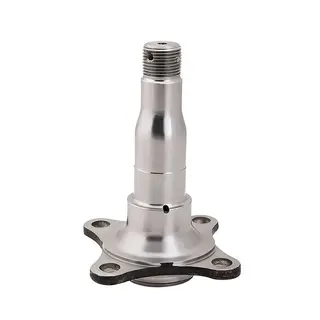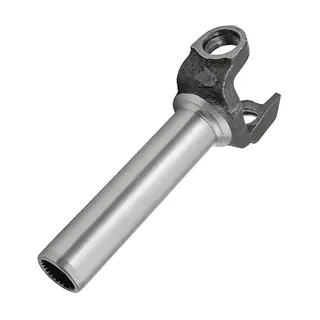In modern industrial production, metal plastic working is of particular significance. Through processes like forging, simple metal blanks can be transformed into products of various shapes and sizes, catering to the needs of different fields. Today, let's delve into the various phenomena, principles, and optimization methods in forging processes to help you better understand this complex yet exquisite technological process.
Forging processes have a significant impact on the mechanical properties of metal materials. During forging, the internal microstructure of the metal undergoes substantial changes, resulting in directional mechanical properties of the material.
In the original casting microstructure, impurities are typically distributed along grain boundaries. When the metal undergoes forging, as the grain boundaries deform, these impurities are elongated and aligned in the direction of metal flow. Meanwhile, the metal grains are also fragmented and elongated along the direction of deformation. After the forged metal undergoes recrystallization, the elongated grains revert to equiaxed grains, while the impurities, lacking crystallization ability, remain as elongated streaks. This phenomenon forms the fibrous structure of the metal.
The fibrous structure can be revealed through the macroscopic microstructure (low magnification) of the metal. The degree of fibrous structure formation depends on the forging ratio; the higher the forging ratio, the more pronounced the fibrous structure. During forging, brittle impurities are fragmented and distributed in a granular or chain-like manner along the main elongation direction of the metal, while ductile impurities are distributed in a band-like manner along the main elongation direction with the metal deformation. Thus, the metal microstructure after hot forging exhibits a certain directionality, commonly referred to as forging flow lines, also known as flow patterns. The forging flow lines are conceptually the same as the fibrous distribution of grains (inclusions).
This directionality causes the metal properties to exhibit anisotropy. For example, pure drawing forging can enhance the longitudinal properties, making them superior to the transverse and tangential properties. Generally, the ductility and toughness in the longitudinal direction are higher than those in the transverse and tangential directions, while the impact on ultimate strength and yield strength is relatively minor.
During plastic deformation, metals exhibit a phenomenon known as work hardening. When metals or alloys undergo plastic deformation below their recrystallization temperature, their deformation resistance increases with the degree of deformation. At this point, the strength and hardness of the metal are enhanced, while ductility and toughness are reduced. The greater the degree of deformation, the more pronounced the changes in the metal's properties. The fundamental reason for the work hardening phenomenon is that during plastic deformation, as slip progresses, the lattice near the slip plane becomes distorted and disordered, generating internal stresses. This leads to grain fragmentation and elongation of grains in the direction of the applied force, increasing slip resistance and making it more difficult for the metal to continue deforming.
However, when cold-deformed metals are heated to a certain temperature (approximately 0.25 to 0.30Tm, where Tm is the melting point of the metal), atoms return to their equilibrium positions, and the residual stresses within the grains are significantly reduced. This phenomenon is called recovery (or sometimes referred to as recovery). During the recovery process, the shape of the grains does not change.
In metal plastic working, several key indicators need to be closely monitored:
Yield-to-Tensile Strength Ratio: The ratio of the yield point to the ultimate strength during material tensile testing is called the yield-to-tensile strength ratio, denoted as σs/σb. This ratio can roughly reflect the potential of metal materials to withstand plastic deformation. A lower yield-to-tensile strength ratio indicates better ductility of the metal material.
Hot Strength: The strength index of a material subjected to both high temperature and external loading (short-term or long-term) is referred to as hot strength. Hot strength includes high-temperature creep limit, high-temperature rupture strength limit, high-temperature fatigue limit, as well as the yield point and ultimate strength at high temperatures.
Good metal plasticity is crucial for plastic forming during metal plastic working processes. To enhance metal plastic deformation, the following aspects can be considered:
The reasonable selection of deformation temperature and deformation speed during the deformation process is key to ensuring good plasticity of the metal during forming. If the selected deformation temperature is too high, it is likely to cause overheating of the deformed metal, leading to coarse grains. Conversely, if the selected temperature is too low, work hardening will occur during metal deformation, increasing deformation resistance and reducing the plasticity of the forged metal. In severe cases, this may even lead to deformation cracking.
For materials with high sensitivity to deformation speed, it is necessary to reasonably select the deformation speed. Generally, hammer-type equipment has a high deformation speed, hydraulic presses have a low deformation speed, and press machines have a deformation speed that lies between the two. For example, in the case of magnesium alloy forging, it is suitable to be carried out on a press machine. If die forging is to be performed on a hammer, it should start with light blows, and as the die cavity fills up, the deformation degree per hammer blow can be gradually increased.
The choice of deformation method directly affects the plastic flow and stress state of the deformed body in the die cavity. The more compressive stresses a blank experiences during deformation, the better its plasticity. Therefore, when performing plastic deformation, for materials with low plasticity, measures can be taken to increase the triaxial compressive stress state to prevent blank cracking. For example, during upsetting, measures such as using movable collars or jackets that are conducive to forming can be adopted; during drawing, using a die anvil for drawing is beneficial for forming and can also improve drawing efficiency.
The chemical composition and microstructural properties of alloy ingots are often quite non-uniform. Before plastic working, high-temperature diffusion annealing can be performed to homogenize the ingot's microstructure and composition, thereby enhancing the material's plasticity. However, since high-temperature homogenization treatment has a long production cycle and is costly, it can be substituted by appropriately extending the soaking time out of the furnace during forging heating. It should be noted, however, that this method reduces productivity and should avoid grain coarsening.
Non-uniform deformation can cause additional stresses, leading to a decrease in the plasticity of the blank and even promoting crack formation. To reduce non-uniform deformation, the following measures can be taken: reasonable operating procedures, good lubrication, and appropriate tool and die shapes can all effectively reduce the non-uniformity of deformation. For example, during drawing, a suitable feed amount should be selected. If the feed amount is too small, it may cause the center of the blank to be inadequately forged, generating additional stresses, and in severe cases, forming internal cracks. During upsetting, measures such as multi-layer upsetting and using soft metal shims can be adopted to reduce the bulging of the blank and prevent surface cracking.
To facilitate the spinning forming of metal blanks, reduce deformation resistance, and save equipment energy, the following methods can be employed in the forging process:
Understanding Material Properties: Gain knowledge of the material properties of the forgings and select reasonable deformation temperature, speed, and extent.
Promoting Uniformity of Material Chemical Composition and Microstructure: For example, high-temperature homogenization treatment of large high-alloy steel ingots can be conducted to enhance the material's plasticity.
Choosing the Most Favorable Deformation Process: For example, when forging hard-deforming, low-plasticity high-alloy steel forgings, to ensure that the material surface is under compressive stress during upsetting and to prevent tangential tensile stress and cracking, the forging tube upsetting process can be adopted.
Utilizing Different Tools: Proper use of tools can improve the non-uniformity of deformation. For example, for shaft forgings, V-shaped anvils or round anvils can be used to increase surface pressure on the forgings, thereby enhancing plasticity and preventing the generation of surface and internal cracks.
Improving Operating Methods: For example, for low-plasticity disc forgings, a process of first upsetting two pieces together and then upsetting each piece by 180° can be adopted to address the issue.
Better Lubrication Measures: Good lubrication measures can improve surface conditions, reduce the impact of friction, achieve uniform deformation, and thus reduce deformation resistance.
Metal plastic working is a complex and exquisite technological craft. Through forging and other process means, we can transform simple metal blanks into products of various shapes and sizes. During the forging process, the internal microstructure of the metal undergoes significant changes, which in turn affect its mechanical properties. Work hardening and recovery phenomena are important occurrences in the metal plastic deformation process, and properly controlling these phenomena is crucial for enhancing metal plasticity. By reasonably selecting deformation temperature and deformation speed, choosing appropriate deformation methods, improving the microstructural and mechanical properties of alloy ingots, reducing non-uniform deformation, and optimizing operating methods in the forging process, the ability of metal plastic deformation can be effectively improved, thereby better meeting the needs of industrial production.
It is hoped that this article can help readers better understand the forging processes and optimization methods in metal plastic working, providing valuable references for practitioners in related fields.



